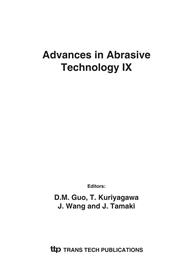p.137
p.145
p.151
p.157
p.163
p.169
p.175
p.181
p.187
Laser Truing and Dressing of Small Vitrified CBN Grinding Wheel
Abstract:
This paper aims at the development of an alterative technique for truing and dressing a small vitrified CBN grinding wheel used for the internal finishing of small holes measuring several millimeters in diameter. In conventional truing and dressing, a single-tip diamond dresser or a rotary GC cup wheel dresser is employed. This levels off the improvement in the wheel truing accuracy because the stiffness of the grinding wheel shaft with an open-sided structure is low, and the shaft is thus deformed easily due to the truing force. In the present work, a new truing and dressing technique is proposed in which a Nd:YAG laser beam is employed as the dresser. Experiments were carried out with respect to the effects of the laser beam conditions (amplitude, width and frequency of pulse, and focus offset) and the relative motion between the laser beam and CBN wheel. It was found that the run-out of the CBN wheel was decreased significantly, and the wheel surface condition was improved greatly after laser truing and dressing.
Info:
Periodical:
Pages:
163-168
Citation:
Online since:
January 2007
Authors:
Keywords:
Price:
Сopyright:
© 2007 Trans Tech Publications Ltd. All Rights Reserved
Share:
Citation:


